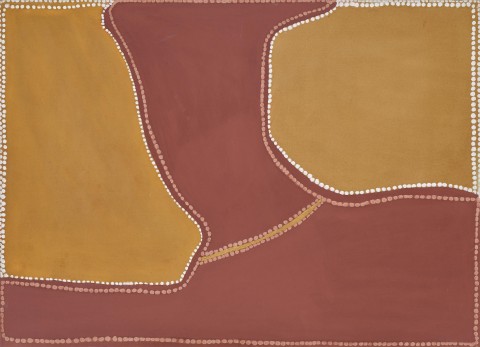LISSADELL STATION, 1990
ROVER THOMAS JOOLAMA
natural earth pigments and synthetic binder on canvas
100.5 x 140.0 cm
bears inscription verso: artist’s name, size and Waringarri Artists cats. AP3356 and S-2804
Waringarri Arts, Kununurra, Western Australia
Chapman Gallery, Canberra
Private collection, New South Wales, acquired from the above in April 1993
This painting is accompanied by a certificate of authenticity from Waringarri Arts, Kununurra
Individual in style, the paintings of Rover Thomas created a new typology and visual language distinct to the east Kimberley region of Western Australia. By condensing complex mythological and topographical information and paring it back to its bare bones, Thomas articulated a highly personal way of telling stories and establishing connection to the land and its related ceremonies. His paintings map tracts of country utilising both planar and aerial views of land, whilst exploring the regional history and ancestral tales of these same locations.
Painted in the same year that Thomas and Trevor Nickolls (1949 - 2012) became the first Aboriginal artists to represent Australia at the Venice Biennale, Lissadell Station, 1990, is characteristic of his work. Executed in earth pigments, the painting depicts an aerial view of the landscape where a central red ochre expanse narrows between two imposing and irregular forms painted in yellow pigment. These forms, which recall the rocky outcrops of the Kimberley plateau, are outlined in white dots made from huntite, a type of chalky white pigment. When used in ceremonial contexts and rock art in the eastern Kimberley, huntite is applied raw (that is, with little or no fixative) in order to retain its elemental purity. In his earlier canvases, Thomas applied the pigment in a similar way and over time, the huntite tended to absorb the resins in the surrounding paint. In this work, the white dots on the red ochre have taken up the underlying colour and become a deep pink.
According to the accompanying Waringarri Arts catalogue notes, Thomas has depicted the traditional story of the Bat and the Crocodile. The painting shows the place on Lissadell Station where, in mythological times, the Crocodile (Lalanggarrany), a renowned dancer, was killed by the Bat (Binyjirrminy). Thinking the Crocodile would be good tucker and wanting him killed, the goanna told Bat that Crocodile had said he was too smelly. That evening everyone gathered for the Joonba (Ceremony) and Crocodile, dressed in his tall paperbark headdress, danced in the light of the fire. Lurking in the shadows and feeling slighted by Crocodile, Bat produced a spear and threw it, hitting him in the side and killing him. Everyone chased Bat, who escaped to the limestone caves on Lissadell Hill. Safely hidden in the caves, Binyjirrminy transformed into a bat permanently, hiding in the caves by day and venturing out only at night.
CRISPIN GUTTERIDGE
